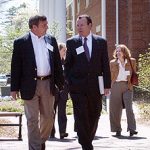 At a mini-conference titled “Future Directions in Communications,” professionals in the mass communications industry spoke to Elon students in the School of Communications April 5 about the technological and structural trends that are shaping today’s media industry. In 28 different sessions, each lasting 30 minutes, nine professionals from various communications fields-including journalism, broadcast, new media, market research and corporate communications–addressed the dramatic shifts in the industry and discussed how students can be better prepared to enter the field. The professional speakers were all members of the Elon School of Communications Advisory Board, which meets twice per year to speak to students and advise the School on course direction. (Pictured above, Jim Hefner, left, vice president and general manager, WRAL-TV and Tom Howe,
At a mini-conference titled “Future Directions in Communications,” professionals in the mass communications industry spoke to Elon students in the School of Communications April 5 about the technological and structural trends that are shaping today’s media industry. In 28 different sessions, each lasting 30 minutes, nine professionals from various communications fields-including journalism, broadcast, new media, market research and corporate communications–addressed the dramatic shifts in the industry and discussed how students can be better prepared to enter the field. The professional speakers were all members of the Elon School of Communications Advisory Board, which meets twice per year to speak to students and advise the School on course direction. (Pictured above, Jim Hefner, left, vice president and general manager, WRAL-TV and Tom Howe,
director and general manager, UNC-TV)
Consensus among all professionals at the conference was that students will be entering the field during the most dramatic changes the media industry has ever seen. With the emergence of multiple technological platforms, speakers discussed the need to understand the “convergence” of different media businesses, the rise of consumer-generated content, and the ethical implications of these shifts for future professionals.
Lee Rainie, director of the Pew Internet and American Life Project, discussed how the business models of traditional media are now in disarray. As an example, he used the impact of the web site Craigslist on traditional classified advertising and the impact of downloadable movies on the entertainment industry. He also discussed the significant increase in citizen participation in news and information delivery, saying that 35 percent of Internet users have created content of some type that is available to other online users.
User-generated content was further discussed by Reggie Murphy, director of research services for Gannett Co. Inc. Murphy showed students a web site for the Gannett-owned Cincinnati Inquirer which is an example of “micro-zoning,” a means of creating niche, online content for small communities within the Inquirer’s larger territory. As part of the site, at NKY.com, readers can add their own content to the site, including photos or news on events happening in their specific area. “Through our research, we have found a need for news and information on a niche basis,” Murphy said. (Pictured below, Lee Rainie, left, director of the Pew Internet and American Life Project, and School of Communications dean Paul Parsons)
 Along with convergence and fracturing of news audiences comes a host of ethical implications and questions about the role of the news media in our democracy. According to Mary Beth Marklein, education reporter for USA Today, economics and convergence are driving decision-making in newsrooms today, making it less likely that journalism is making the difference that it once made in a democratic system. In such an environment, Marklein said that teaching ethical journalism practices has become paramount.
Along with convergence and fracturing of news audiences comes a host of ethical implications and questions about the role of the news media in our democracy. According to Mary Beth Marklein, education reporter for USA Today, economics and convergence are driving decision-making in newsrooms today, making it less likely that journalism is making the difference that it once made in a democratic system. In such an environment, Marklein said that teaching ethical journalism practices has become paramount.
Ken White, news director of Fox News Charlotte, echoed Marklein’s sentiments, outlining for students the importance of understanding the ethical implications and impact of every news story covered.
If students weren’t quite sure how the vast changes in technology may impact their future professional lives, Debora Wilson, president and chief executive officer for The Weather Channel summed it up for them. Wilson said that technology is changing so fast that new developments occur every day that have the potential to alter the way The Weather Channel operates. To keep up with these changes, Wilson told students that she rises at 4:30 a.m. every day, reads four or five newspapers and skims through 200 email deliveries to continually monitor new developments. The hard part, she said, is staying on top in this competitive field where digitization allows for more competition all the time.
Public relations expert Joe Gleason, president of The Gleason Group, also noted how technology and transparency are affecting corporations, making them more accessible, and more accountable, to their publics. As this environment emerges, Gleason said that public relations executives are becoming more crucial to upper-level management. He noted that the lines are blurring between PR executives and management consulting firms, with each vying for the role of consulting with chief executives.
Other speakers at the conference included Sunshine Overkamp, president of Overkamp Overkamp Smith agency; Tom Howe, director and general manager of UNC-TV; and, Jim Hefner, vice president and general manager of WRAL-TV. More than 200 students attended the conference held in McEwen.
“The wealth and depth of information shared at this mini-conference exemplifies how important our professional advisory board is to the School of Communications,” said Connie Book, associate dean of the School of Communications. “Especially in this time of technological upheaval, the board provides a vital connection to the industry that helps us keep pace with a vastly-changing environment.”


